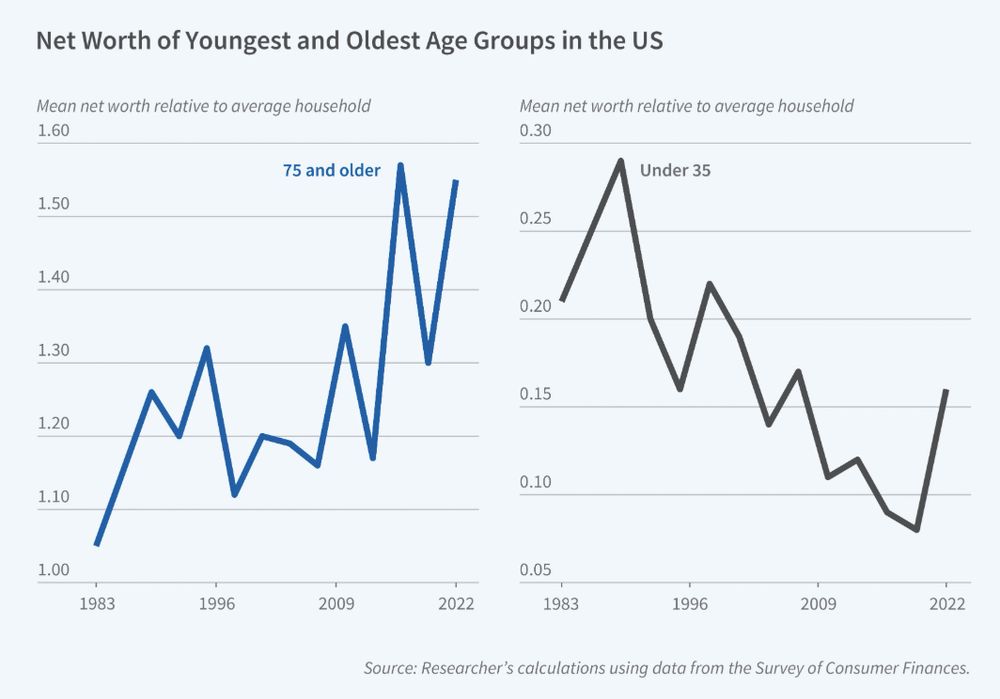
From Politico in July 2020:
www.politico.com/news/2020/07...
@florianederer.bsky.social
Austrian 🇦🇹 Economist 📈 Not an Austrian Economist Allen & Kelli Questrom Professor BU Questrom, NBER, ECGI & NBER https://florianederer.github.io/

From Politico in July 2020:
www.politico.com/news/2020/07...
Just a few years ago the economics profession completely marginalized @claudia-sahm.bsky.social for speaking out on this matter.
17.11.2025 14:11 — 👍 87 🔁 35 💬 1 📌 0Summers conferred with Epstein frequently about how to extract sexual favors from a Harvard econ grad (AB '04, PhD '09)
The grad is from China
Epstein and Summers referred to her by the codename "Peril"
Racism and sexual exploitation in one efficient package
bit.ly/3LHpin8
I think he just made it up.
14.11.2025 02:56 — 👍 1 🔁 0 💬 0 📌 0

IO is so cooked.
14.11.2025 02:12 — 👍 6 🔁 0 💬 0 📌 0

I updated the Larry Summers dual-axis inflation graph.
14.11.2025 01:58 — 👍 9 🔁 2 💬 3 📌 0jmp pitch for the brave: how well does presence of faculty in this dataset predict university *jmr IP shares
13.11.2025 19:47 — 👍 14 🔁 5 💬 1 📌 0As close to perfect as a videogame can get.
13.11.2025 03:48 — 👍 8 🔁 0 💬 0 📌 0
@stevesalop.bsky.social has an excellent write-up in @ProMarket_org about why the proposed merger between Novo Nordisk and Metsera was anticompetitive.
www.promarket.org/2025/11/11/n...
Never thought of using classes. As Director of Undergraduate Studies, I had a lonely-hearts advice practice for young men (True rumor circulated that I had married before graduation.) Most common and most obvious advice: "Have you considered asking her out?"
09.11.2025 18:45 — 👍 13 🔁 1 💬 1 📌 0I was told that selectively coupling students to create the Kwisatz Haderach would not look good on my promotion file, but I chose to ignore that advice.
09.11.2025 15:50 — 👍 8 🔁 0 💬 1 📌 0Coupling this, fertility that.
Why don't you academics actually do something about it?!? 😂

Beautiful article on Ali Riley who has retired after an amazing career in soccer.
(If her last name sounds familiar to you as an economist, then that's no surprise. She's the daughter of UCLA auction theorist John Riley.)
www.nytimes.com/athletic/678...
this is cool. emily wilson's (controversial!!) 'complicated' is her shot at 'πολύτροπος,' which is like literally 'many-turning' and therefore almost completely untranslatable as a personal descriptor
04.11.2025 23:13 — 👍 5 🔁 1 💬 0 📌 0Supergiant did their fucking homework on these games and it's awesome.
(See also the joke in Hades 1 where Zagreus and Dionysus prank Orpheus by convincing him they're secretly the same guy; in the "Orphic" myths they are!)
THIS is the type of Hades 2 “breakdowns” I’m looking for. Love me some dual translation references 🤣
05.11.2025 01:50 — 👍 4 🔁 1 💬 0 📌 0Yes, I wonder if she knows about the game.
05.11.2025 12:57 — 👍 3 🔁 0 💬 0 📌 0It's the only guilty videogame pleasure I allow myself.
05.11.2025 00:24 — 👍 1 🔁 0 💬 0 📌 0
Hades II is amazing. There are nods to both Lattimore's and Wilson's Odyssey translations.
Lattimore: “Tell me, Muse, of the man of many ways…”
Wilson: “Tell me about a complicated man…”
Hades II: “Some know him as the man of many ways; certainly he is a complicated one.”

In 1983, households aged 75+ were 5% richer than the average. In 2022, they were 55% richer.
Meanwhile, under-35 households went from 21% of average wealth to just 16%.
America’s wealth is aging way faster than its population.
www.nber.org/digest/20251...
New WP (by me and others) on how disclosure mandates:
(1) increase disclosure (primarily of negative outcomes), and (2) how expectations of increased disclosure by others slows down innovation.
Link and more details in @florianederer.bsky.social's thread...

The program is fully funded, offers rigorous economics training with BU Econ, and features faculty in IO, health, labor, innovation, and applied micro. Located in Boston's rich research ecosystem.
Curriculum:
www.bu.edu/questrom/phd...
Q&A:
insights.bu.edu/the-launch-o...

BU Questrom is launching a new PhD Program in Business Economics focused on how markets and firms interact with public policy.
Graduates will be ready for research and teaching roles in both business schools and econ departments.

P.S.: My fantastic co-author Zhichun Wang is on the economics job market this year with super interesting work on the expansion and dynamic equilibrium effects of institutional landlords.
sites.google.com/view/zhichun...
Mandated disclosure helps society learn from failure, but it can also make firms wait to learn from one another.
Transparency improves information flow, but too much of it can cause innovation to stall.


Firms began taking longer to complete trials and waited to start new ones, especially when competitors’ results were about to be released.
They also reduced the number of trial sites by about half, becoming more cautious as other firms' data became public.


Transparency helps innovation ... until it doesn't.
My new paper with Cunningham, Hodgson, and Wang (on the JM!) studies the 2017 FDA Final Rule, which required drug firms to publicly disclose all clinical trial results.
Disclosure increased, but innovation slowed.
cowles.yale.edu/sites/defaul...

Do incumbents buy startups to scale innovation or to stifle it?
New research covering 60 countries finds that acquired startups were highly innovative before their acquisition, but their patenting drops sharply afterward, while acquirers' innovation doesn't rise.
www.oecd.org/en/publicati...

Private credit has exploded. But why?
It's not just replacing banks. It's also private equity's new frontier:
BDCs now blend debt and equity, offer PE-like returns with less risk, and cater to a growing base of retail investors.
melaniewallskog.github.io/files/robins...
I’ve decided not to post my annual “women on the Econ job market” thread this year. Social media has splintered too much, and now that I’ve left academia I’m focused on other priorities.
14.10.2025 14:02 — 👍 55 🔁 13 💬 2 📌 1